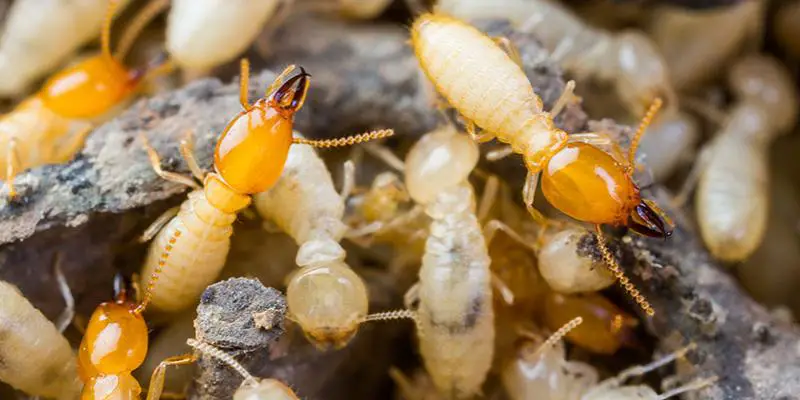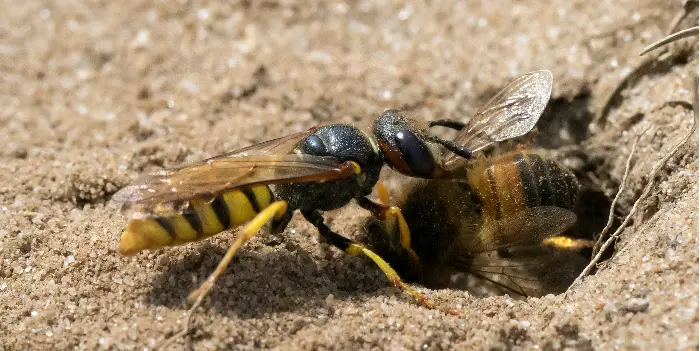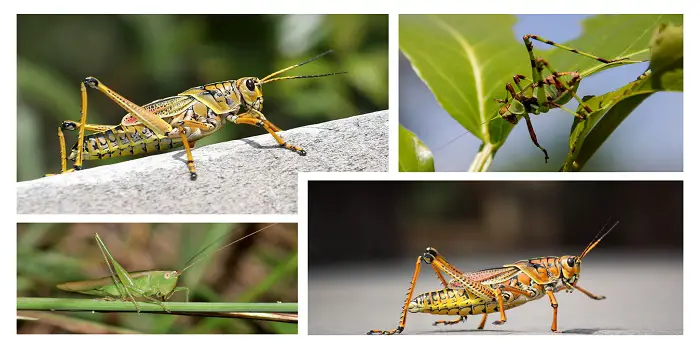
Grasshoppers and katydids can be the worst nightmare for a gardener in high numbers, especially in rural areas.
Though high infestation may be tough to remove, their population and damage can be vehemently lessened with a cautious selection of plants, the correct inclusion of predators, and the effective use of organic insecticides.
However, in order to control the katydids and grasshoppers, you should first know about the basic difference between both these insects and then the prevention methods.
Also, it’s essential to gain a better knowledge of how these insects feed and reproduce to get multiplied soon.
So let’s start with…
Grasshopper vs. Katydid
Although katydids are many times referred to as grasshoppers, they are not the same, and there are several differences between them.
The critical difference between grasshopper and katydid lies in their antennae.
While grasshoppers have short antennae with sharp ovipositors, katydids have long antennae with sword-like sharp ovipositors.
You can tell them apart by looking at the antennas of katydids which are as long as their green body.
Unlike grasshoppers, katydids like to rest on herbaceous plants, and they rarely damage the garden plants seriously.
Also, grasshoppers generally lay their eggs on the ground, whereas katydids prefer to lay their eggs on plant parts.
Where Does Grasshoppers Lay?
There are more than 11,000 different species (or types) of grasshoppers found around the world.
Each of these species has unique characteristics, and their body can be of colors like red, green, black, yellow, and brown.
Grasshoppers usually lay their eggs (in pod-like structures) during winters.
They keep the eggs safe by laying them inside the soil, where they hatch them in springs.
What do they eat?
Grasshoppers are omnivores.
Once the eggs hatch, they start feeding on grasses and broadleaf veggies.
At times they can scavenge dead plant matter. They can even feed on dead grasshoppers or the remains of other insects.
Gardens that are well-watered and have a plethora of vegetation are a favorite habitat for grasshoppers and katydids.
They like to stay there as long as the food supply is available.
As soon as no further food supply is available, winged adults fly in search of a new food source, while immature grasshoppers remain because they can’t fly.
One of the best ways to avoid this is to make the area less favorable to grasshoppers which makes living difficult for them.
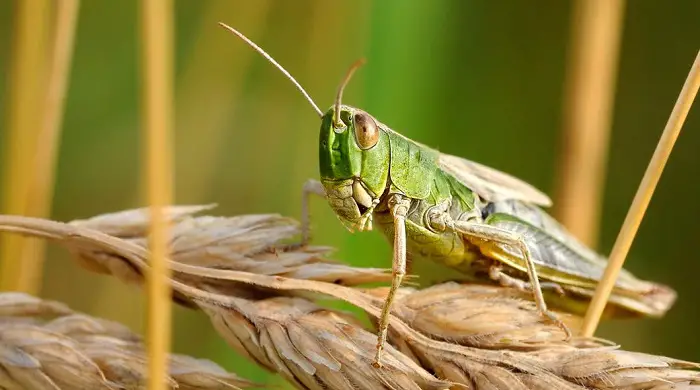
How to Kill Grasshoppers in the Garden Naturally?
Though not as damaging as locusts, grasshoppers in huge numbers can damage your garden vegetation and prove to be a huge threat to those living off the grid.
The highest health hazards come from the after-effects of a grasshopper visit.
As they like foliage, they can damage your vegetation and kill your crops slowly and steadily.
Fortunately, a variety of different natural remedies are available that are highly effective.
Some of them you can try include:
1- Neem oil
Extract of the neem tree has natural disinfectant properties which permit it to be used in several home products such as toothpaste.
Just like chemical insecticides, neem oil also works incredibly well against grasshopper nymphs.
Neem oil spray can inhibit the egg-laying process of grasshoppers and, at the same time, disrupts their life cycle.
Not only does it work by repelling grasshoppers away, but also it shows great results on adults by killing them.
Due to all these reasons, gardeners love using this popular organic method for grasshopper and katydid control.
2- Boric Acid
Boric acid is an age-old remedy that works amazingly well against grasshoppers, just like it does to any other pest.
Sprinkle it along the edges of your walls and on plants inside the house.
The acid will lacerate the legs of the grasshopper and other bugs as they get in contact with it.
Plus, it is extremely poisonous and kills the insects as soon as they consume it.
What’s great is that it is usually safe for household use; however, make sure you keep it out of the reach of your kids and pets.
3- Natural Insecticides
Using chemicals to eradicate grasshoppers can be dicey as they get resistant to pesticides with time.
However, insecticides with permethrin or acephate carbaryl are highly effective and can help you get rid of giant grasshopper (lubbers) if you have them in your garden.
An environmentally friendly insecticide, Ecobran grasshopper killer is also a good option you can try.
It makes use of carbaryl in a unique mix that is only meant to harm orthoptera insects and not birds or favorable insects.
This property makes these sprays a great friend for gardeners.
4- Tilling the Ground
Females generally lay their clutch of eggs beneath the soil surface where they won’t get disturbed.
If you till your garden around September, they will instantly leave your yard and go elsewhere to look for their nesting ground.
An additional benefit of turning grass and tilling your ground cover to compost is it makes your garden soil enriched for next year’s vegetation growth.
5- All-Purpose Wheat Flour
An uncommon but efficient solution is all-purpose flour.
It gets sticky when grasshoppers eat it and causes their mouth to stick up to starve the critters.
All you need to do is sprinkle some of it in thin layers on the plant leaves and ensure it is not any other kind of flour.
Some flour contains salt, which can damage the plants, so make sure you use only all-purpose flour for this purpose.
6- Hot Pepper Spray
Grasshoppers and katydids hate hot peppers and garlic.
You can make a spray using these kitchen products to spray on the plant’s leaves.
This will make them uneatable with grasshoppers.
However, it has a side effect that your tomatoes could get a lot spicier if you don’t wash them nicely.
Garlic spray is a great natural grasshopper repelling spray and can be preferred if you want to consume some of the plant parts later.
7- Get Some Frogs
If you own a pond in your yard, then get some frogs or toads.
These amphibians like to eat insects and work as a great defense against all types of harmful bugs including grasshoppers and katydid bugs.
Just ensure that you don’t want to remove frogs later.
If you don’t like frogs, then lizards are also an option for you as they like to treat grasshoppers a lot.
8- Bird or Chickens
There are several species of birds that prey on insects.
Some of them regard grasshoppers and katydids as a treat.
You can just set up some bird feeders to attract them, and they will love to eat these pests as their dessert.
A specific species of bird which you may not have thought of is the chicken.
In many towns, cities, and rural areas, people keep chickens as a pet.
Unbelievable but true, they are very good pets and can eat any insect they can search for.
An additional bonus is that a fertile hen can even give you some eggs daily for your breakfast.
9- Pathogenic Fungus
Although not very safe, fungi that are pathogenic to grasshoppers can help to kill them for sure.
Entomophthora Grylli, for example, is highly dangerous for grasshoppers.
Once infected, it paralyzes a grasshopper by holding them to plants without any escape.
As fungus starts to multiply, they eat the grasshopper making it die in an awkward posture.
However, since the fungi flourish in hot and moist weather, they may not be very effective in northern regions.
Plus, you cannot get this fungus commercially.
Nosema locustae is another excellent alternative if you cannot find Entomophthora Grylli.
You can find this fungus available in stores, especially in bran-based items like Semaspore, Nolo Bait, and Grasshopper Attack.
Though it may not be able to kill adult grasshoppers, it hampers their fertility and is much more effective in killing grasshopper nymphs.
You can apply it during mid-summer. It will work as a long-term solution but will not help eliminate the present year’s infestation.
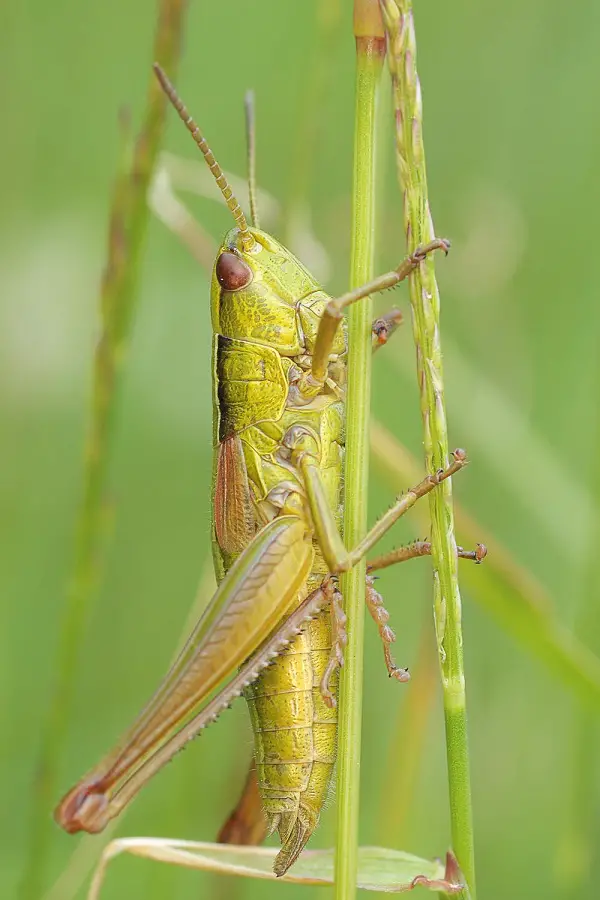
What Plants Keep Grasshoppers and Katydids Away?
One of the easiest ways to ward off insects like grasshoppers and katydids is to prevent them from coming near your plants.
This means you can create such an environment that grasshoppers hate or don’t like to live in.
Flowering plants like Moss rose, Crepe Myrtle, Verbena, Sage, Lilac, and Forsythia have a powerful offensive smell that deters several insects, including grasshoppers and katydids.
Growing plants like garlic, tomatoes, squash, and peas also deter the grasshoppers while making a nice addition to your backyard garden.
These will not only repel the insects but can also be used in your kitchen for preparing great recipes.
While growing the plants that grasshoppers hate, remember that environmental grasshopper control methods like these can be slow and take a few months.
That’s the reason I suggest using these plants around the boundary of your garden as a preventive measure.
You should start growing these plants in early spring and give them enough time to work.
It can work very effectively when combined with other pest control methods to keep these pesky bugs away.
Other Related Questions:
Can grasshoppers bite?
Grasshoppers and katydids are generally harmless to humans and pets.
This means, in most cases, they will not bite people.
But if they feel threatened, they may bite.
Also, certain types may bite when they gather in large swarms.
The good thing is that their bite is less intense – just like the one you feel from a mosquito bite.
Are grasshoppers and katydids poisonous?
The commonly found green grasshoppers and katydids in your garden do not have poison, meaning their bite is not poisonous.
But there are certain grasshoppers found in the wild that can be poisonous, and you should know about them.
Dictyophorus spumans (the koppie foam grasshopper or rooibaadjie), for example, is a grasshopper species in the family Pyrgomorphidae indigenous to Africa.
They are poisonous because of their ability to produce toxic foam from their thoracic glands.
The foam is toxic due to the poisons produced from their diet, including toxic plants like milkweed.
What is the brown liquid that grasshopper spits?
If you try to pick the grasshoppers up, they may “spit” a brown liquid at you which is commonly called “tobacco juice.”
It’s believed that grasshopper regurgitates the contents of their stomach when disturbed.
The spit is in the form of liquid which is designed to protect them from the attacks of their predators (that are mostly lizards, mantids, spiders, birds, and rodents).
The Conclusion
Grasshoppers and katydids are insects that can be very harmful to your garden plants, flowers, crops, and veggies.
While you cannot stop them from eating your plants inside, you can prevent them from coming inside your garden.
If some bugs are still found after trying all the prevention methods, you can kill them using pesticides or other methods.
However, you will need to take proper care when using pesticides inside or outside the home.
When not used correctly, they can present a danger to you, your family, and your pets.
Share the post "How to Stop Grasshoppers and Katydids from Eating Plants?"

Welcome to ProShieldPest.com. I am Tina Jones. I have been working as a pest removal professional in Winslow, Arizona lately. At present, I love to spend my time with my family as a retiree.
Here I share all my knowledge and experiences to help people understand better how they can stop pests at their homes without actually killing them. Hopefully, the information you will find here will help in safeguarding your home! You can check more about me here.

